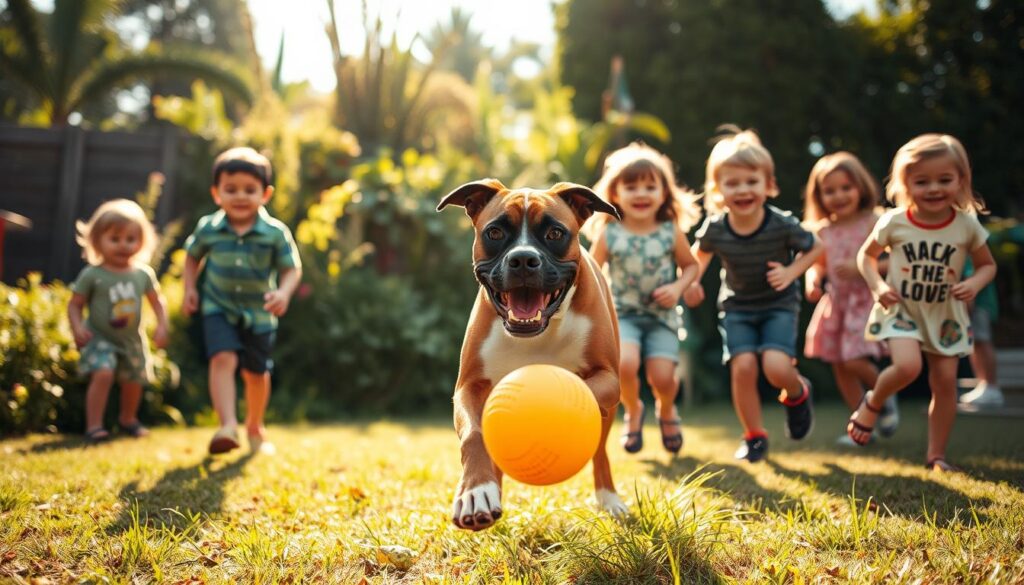Did you know that 1 in 5 Boxers have a white or mostly white coat? Also, 18% of these white Boxers are deaf in at least one ear. This shows how special the Boxer breed is, loved by many in the U.S.
Boxers are great family pets because of their strong build and fun nature. They are medium-sized, growing 20 to 25 inches tall and weighing 55 to 65 pounds. This makes them big enough to be impressive but small enough to be easy to handle.
Boxers have won the hearts of many, thanks to the American Kennel Club recognizing them in 1904. Their smartness, loyalty, and high energy have kept them in the top 10 most popular dog breeds in the U.S. for years.
Boxers are not just good family pets but also excel as working dogs. They are versatile, serving in roles like service animals and athletes. With an average life span of 8 to 12 years, they bring lots of happiness and companionship to their owners.
Key Takeaways
- Boxers have a unique coat color distribution, with 20% being white or mostly white
- The breed ranks consistently in the top 10 most popular dogs in the U.S.
- Boxers typically live 8 to 12 years
- They excel in various roles, including as family pets and working dogs
- The breed was recognized by the American Kennel Club in 1904
Boxer Temperament
Boxers are known for their unique traits that make them great friends. They are friendly, protective, and full of energy. This mix makes them perfect for family life.
The Friendly Companion
Boxers love being around people. They don’t like to be alone for long. Their playful nature stays with them into adulthood, making them adorable to families.
Protective Nature
Boxers are friendly but also protective. They are great watchdogs, always ready to defend their family. Their loyalty makes them excellent guardians.
Energy and Playfulness
Boxers have lots of energy. They need 1-2 hours of exercise every day. Their playful nature makes them great playmates for active families.
Breed Overview
| Attribute | Details |
|---|---|
| Lifespan | 10-12 years |
| Size | Males: 23-25 inches; Females: 21-23 inches |
| Weight | Males: 60-70 pounds; Females: 50-60 pounds |
| Temperament | Friendly, playful, loyal, intelligent |
| Exercise Needs | High (1-2 hours daily) |
| Trainability | Easy with positive reinforcement |
Knowing a Boxer’s temperament is key for owners. They bring joy and protection but need commitment. Their energy and strong personalities suit active families well.
Health Considerations
Boxers are known for their strong build and fun nature. They face special health challenges. As fighters in the heavyweight and middleweight categories, they need extra care for their health.
Common Boxer Health Issues
Boxers often deal with health problems. Heart issues, like cardiomyopathy, affect nearly half of them. Cancer is also a big concern, hitting 38% of Boxers.
Hip dysplasia, which can cause mobility issues, affects about 25% of Boxers.
Recommended Vet Visits
Regular vet visits are essential for Boxers. I suggest seeing the vet at least twice a year. These visits help catch issues early, like skin problems and thyroid issues that can change behavior.
Vaccination Needs
Getting the right vaccinations is important to keep Boxers healthy. They need core vaccines for rabies, distemper, parvovirus, and hepatitis. Your vet might also recommend non-core vaccines based on your Boxer’s life and risks.
| Health Issue | Prevalence in Boxers | Prevention/Management |
|---|---|---|
| Cardiomyopathy | 48% | Regular heart screenings |
| Cancer | 38% | Regular check-ups, early detection |
| Hip Dysplasia | 25% | Weight management, exercise |
| Dermatitis | 15% | Regular grooming, diet management |
Training Your Boxer
Training a Boxer is like coaching a boxer in the ring. You need patience, consistency, and creativity. Boxers are smart but can be stubborn. So, start early and stay committed.
Basic Commands
I start training my Boxer puppy at three weeks old with simple commands. “Sit,” “Stay,” and “Come” are the basics. These are key for safety, like during outdoor play.
As we move forward, I teach more advanced commands. This helps prevent them from trying to escape.
Socialization with Others
The critical period for socialization is between 8 to 16 weeks. I expose my Boxer to different people, animals, and places during this time. It’s important to be careful.
I avoid contact with unvaccinated dogs until after 16 weeks. This prevents disease. Many training clubs accept puppies as young as 8 weeks with proof of first vaccinations.
Training Techniques
Positive reinforcement is my go-to in training. I use praise, treats, and toys to reward good behavior. Punishment can make them aggressive, so I avoid it.
I keep training sessions short and fun. I teach basic tricks like sit, stand, roll, and kneel. These tricks help their mental development and build trust.
Remember, Boxers mature late, so patience is key. With consistent training, your Boxer will become a well-behaved companion.
Exercise Requirements
Boxers are full of energy and love to stay active. They have a strong build and need regular exercise to stay healthy. As a Boxer owner, I know how important it is to meet their exercise needs.
Daily Activity Level
A grown Boxer needs about 90 minutes of exercise each day. I break this into two 45-minute walks. For puppies, start with 5 minutes of exercise per month of age, twice a day. This helps prevent joint and bone problems as they grow.
Ideal Exercise Routines
As Boxers get older, they need more exercise. I use a PitPat Dog GPS Tracker to keep an eye on my Boxer’s activity. For adult Boxers, I suggest:
- Leashed walks: Start with 30 minutes at 6 months, increase to 60 minutes by 18 months
- Fetch: Great for burning energy, limit sessions based on age
- Swimming: Safe for puppies over 6 months
- Agility training: Excellent for mental and physical stimulation
Boxers can easily get overweight, so regular exercise is vital for a healthy weight.
Fun Activities to Engage Them
Boxers enjoy playing games. I keep my Boxer entertained with:
- Tug-of-war using durable gloves
- Hide-and-seek with treats
- Obstacle courses in the backyard
- Jogging (for adult Boxers)
These activities keep them physically and mentally active. Remember to adjust the intensity of exercise as your Boxer ages, keeping it regular.
Feeding Your Boxer
Feeding your boxer is important. They need a diet that supports their active lifestyle. I’ll help you understand what they need, including nutritional requirements and recommended brands.
Nutritional Needs
Boxers need high-quality protein to stay healthy. Puppies require 22-26% protein, and adults can handle a bit more. It’s also important to avoid foods with common allergens like wheat, corn, and soy.
Recommended Food Brands
Look for brands that use natural ingredients and avoid fillers. ProDog offers several options for boxers:
- ProDog Muscle+: 76% quality protein per scoop
- ProDog Boost: Enriches 80-10-10 raw dog food
- ProDog Colostrum: 100% bovine colostrum for immune support
Feeding Schedule
Keep a regular feeding schedule for your boxer. Adult boxers usually eat two meals a day. Puppies might need three to four smaller meals. Always make sure they have fresh water and watch their weight to adjust portions.
| Age | Meals Per Day | Protein Content |
|---|---|---|
| Puppy (2-6 months) | 3-4 | 22-26% |
| Adult (6+ months) | 2 | 26-30% |
| Senior (7+ years) | 2 | 24-28% |
Grooming and Care
Boxers have a short, smooth coat that’s easy to care for. Despite their size, they need regular grooming to stay healthy and happy.
Bathing Frequency
Bath your Boxer every 4-6 weeks with a dog-friendly shampoo. This keeps their coat clean without losing natural oils. After bathing, use conditioner to remove loose hair and keep their coat shiny.
Brushing and Shedding
Boxers shed moderately, with big molts in spring and fall. Brush them 2-3 times a week to manage shedding. During heavy shedding, brush daily to cut loose hair by 90%.
Ear and Dental Care
Clean your Boxer’s ears weekly to avoid infections. Brush their teeth 2-3 times a week to prevent tartar buildup. Don’t forget to trim their nails every 3-4 weeks for paw health.
| Grooming Task | Frequency | Benefits |
|---|---|---|
| Bathing | Every 4-6 weeks | Maintains coat health |
| Brushing | 2-3 times weekly | Reduces shedding by 90% |
| Ear Cleaning | Weekly | Prevents infections |
| Teeth Brushing | 2-3 times weekly | Reduces tartar buildup |
| Nail Trimming | Every 3-4 weeks | Maintains paw health |
Living with a Boxer
Boxers are wonderful family pets. They are playful, full of energy, and love being around people. These middleweight champions need lots of space to run and play.
Best Housing Environments
Boxers love homes with yards. They need 60-90 minutes of exercise every day. If you live in an apartment, expect lots of walks and dog park visits. They are true knockout athletes who love to stay active!
Lifestyle Adaptability
Boxers are adaptable to different lifestyles. They fit well into active families and quieter homes too. But, they don’t like being alone for too long. About 75% of dog owners say their pets offer companionship and emotional support.
Role as a Family Pet
Boxers are excellent family pets. They are loyal, protective, and wonderful with kids. Early training and socialization are key. Start training when they’re about 8 weeks old to avoid behavior problems. About 30% of Boxers end up in shelters due to these issues.
| Aspect | Details |
|---|---|
| Daily Exercise Needs | 60-90 minutes |
| Average Male Weight | 65-80 pounds |
| Average Female Weight | 50-65 pounds |
| Lifetime Cost | $20,000 – $30,000 |
Boxers and Children

Boxers are known for their patient and playful nature. This makes them a popular choice for families. In fact, about 75% of Boxer owners say their dogs are great with kids. This breed’s friendly demeanor often leads to strong bonds with children, making family activities more enjoyable.
Interaction with Kids
Boxers love to play and can keep up with energetic children. Their medium-to-large size, weighing 50-70 pounds, makes them sturdy for roughhousing. But, they might accidentally knock over smaller kids. I’ve found that Boxers often act like they’re wearing invisible boxing gloves, playfully pawing at their human friends.
Safety Tips for Playtime
While Boxers are great with kids, supervision is key. Here are some safety tips:
- Teach children to respect the dog’s space
- Always supervise interactions, specially with younger kids
- Encourage gentle play, avoiding any ‘uppercut’ movements
- Ensure the dog has a quiet space to retreat when tired
Teaching Kids About Boxers
Educating children about Boxer behavior is important. I recommend involving kids in care routines like feeding and grooming. This helps them understand the dog’s needs and builds a respectful relationship. Remember, a well-socialized Boxer can be a child’s best friend and protector for years to come.
Boxers and Other Pets
Boxers are known for their friendly nature. But, introducing them to other pets needs careful planning. Early socialization is key to positive relationships with other animals.
Introduction to New Pets
Introducing a new pet to your boxer should be done slowly. Start with short, supervised meetings in a neutral area. This lets both animals get used to each other’s scents and presence without feeling scared.
Socialization Strategies
Proper socialization is important for boxers to live well with other pets. Regular playdates with friendly dogs help your boxer learn social skills. For smaller pets, it’s important to watch them closely because of the boxer’s natural prey drive.
Managing Conflicts
Even with the best planning, conflicts can happen. Stay calm and separate the animals if things get tense. Training and positive reinforcement can help reduce aggression in boxers.
| Pet Type | Compatibility with Boxers | Socialization Tips |
|---|---|---|
| Other Dogs | Generally Good | Gradual introductions, Supervised play |
| Cats | Varies | Early socialization, Safe spaces for cats |
| Small Pets | Challenging | Close supervision, Separate living areas |
Remember, every boxer is different. With patience and proper training, your boxer can live peacefully with other pets. This creates a harmonious home for all.
Boxer Lifespan
Boxers are known for their playful spirit and loyalty. They live for 10 to 12 years. Males weigh 65 to 80 pounds and stand 23 to 25 inches tall. Females are a bit smaller.
Life Expectancy Overview
Boxers need 1 to 2 hours of exercise daily. This keeps them healthy and happy. But, they can face health issues like heart problems.
Heart conditions, like right ventricular cardiomyopathy, are common. Regular vet visits are key.
Signs of Aging
As Boxers age, they may slow down. They’re at risk for Gastric Dilatation-Volvulus (GDV) due to their deep chest. Watch for signs of Dilated Cardiomyopathy (DCM).
End-of-Life Care
In their senior years, Boxers need special care. Feed them two meals a day, 12 hours apart. Clean their ears twice a month to prevent infections.
Keeping them lean helps prevent CCL disease. These loyal friends deserve our best care as they age.
Choosing a Boxer
Choosing a Boxer is a big decision. These dogs are strong, fitting into both heavyweight and middleweight categories. They need owners who are ready for the challenge. Let’s explore how to pick the perfect Boxer for your family.
Finding a Reputable Breeder
When looking for a Boxer puppy, find breeders who focus on health and temperament. Good breeders spend weeks with puppies before they’re ready for a new home. They should give you health checks and test results.
Adoption Considerations
Adopting a Boxer can be very rewarding. Many groups specialize in Boxer rescues. Adopted dogs might need more patience and training. Boxers grow and change until they’re about 18 months old.
Assessing Ownership Readiness
Before getting a Boxer, think about your lifestyle. These dogs need lots of space and exercise. They’re not good for apartments or people who don’t move much. You’ll need to train them well, as they’re as strong as middleweight boxers.
Boxers are popular pets in the U.S., ranking 14th. But, their size and energy level aren’t right for every home. Make sure you’re ready for the responsibility before bringing a Boxer home.
Fun Facts About Boxers
Boxers have a long history and special traits that make them loved by many. They’ve captured the hearts of dog lovers for centuries. Let’s dive into some interesting facts about these lovable dogs.
Unique Characteristics
Boxers are known for their expressive faces and the “kidney bean” dance. They are smart dogs that need creative training to stay happy. These athletic dogs can run up to 45 mph, almost as fast as a Greyhound. Boxers come in only three colors: white, fawn, and brindle.
Celebrity Boxers
Boxers have been favorites of celebrities and have shined in dog shows. They’ve won Best in Show at the Westminster Kennel Club Dog Show four times. Famous owners like Humphrey Bogart and Lauren Bacall have loved them.
Popularity in the U.S.
Boxers became popular in the U.S. after World War I, with a big jump in the late 1930s. By 2022, they were the 16th most popular dog breed. Their popularity in America started with four dogs known as “the Four Horsemen of Boxerdom.”
| Foundational Boxer | Notable Achievement |
|---|---|
| Sigurd | Sired 10 champion puppies |
| Lustig | Sired 41 American champions |
| Utz | Sired 35 American champions |
| Dorian | Won Working Group at Westminster in 1937 |
Boxers bring joy to families across America, showing their lasting appeal as pets and working dogs.
Conclusion
Reflecting on Boxers, I’m amazed by their history and unique traits. They are like boxing gloves, full of energy and personality. From their start in 19th century Germany, they’ve become popular pets in the United States.
Final Thoughts
The Boxer breed’s story is like the Boxer Rebellion in China. Boxers are strong, despite their medium size. They’ve overcome challenges, becoming loyal friends.
Summary of Boxer Benefits
Boxers are playful and protective, making them special pets. Their energy is like the international forces that marched to Beijing. Boxers have complex personalities, making them endlessly interesting.
Encouraging Responsible Pet Ownership
Having a Boxer is a big responsibility, like the Boxer Protocol in China. It needs dedication, care, and understanding. By being responsible owners, we help these dogs thrive, just like China did after the Boxer Rebellion.
FAQ
Are Boxer dogs good family pets?
How much exercise does a Boxer need?
What are common health issues for Boxer dogs?
How long do Boxer dogs typically live?
Are Boxer dogs easy to train?
Do Boxer dogs shed a lot?
Can Boxer dogs live in apartments?
Are Boxer dogs good with other pets?
How often should I feed my Boxer dog?
Do Boxer dogs drool a lot?
Are Boxer dogs good guard dogs?
How often should I groom my Boxer dog?
| Source Name | URL |
|---|---|
| Boxer (dog breed) – Wikipedia | https://en.wikipedia.org/wiki/Boxer_(dog_breed) |
| American Kennel Club (AKC) – Boxer | https://www.akc.org/dog-breeds/boxer/ |
| The Kennel Club (UK) – Boxer | https://www.thekennelclub.org.uk/breed-standards/working/boxer/ |
| United Kennel Club (UKC) – Boxer | https://www.ukcdogs.com/boxer |
| American Boxer Club | https://americanboxerclub.org/meet-the-boxer-a-unique-breed/ |







